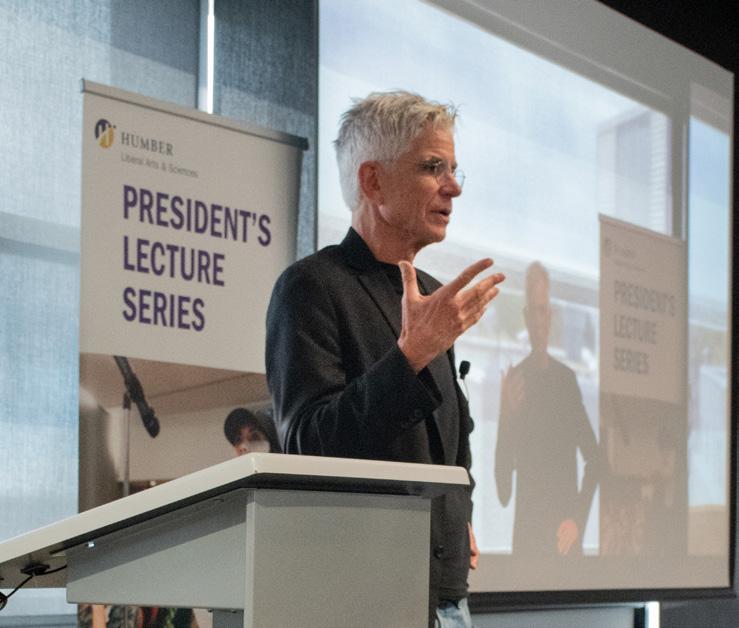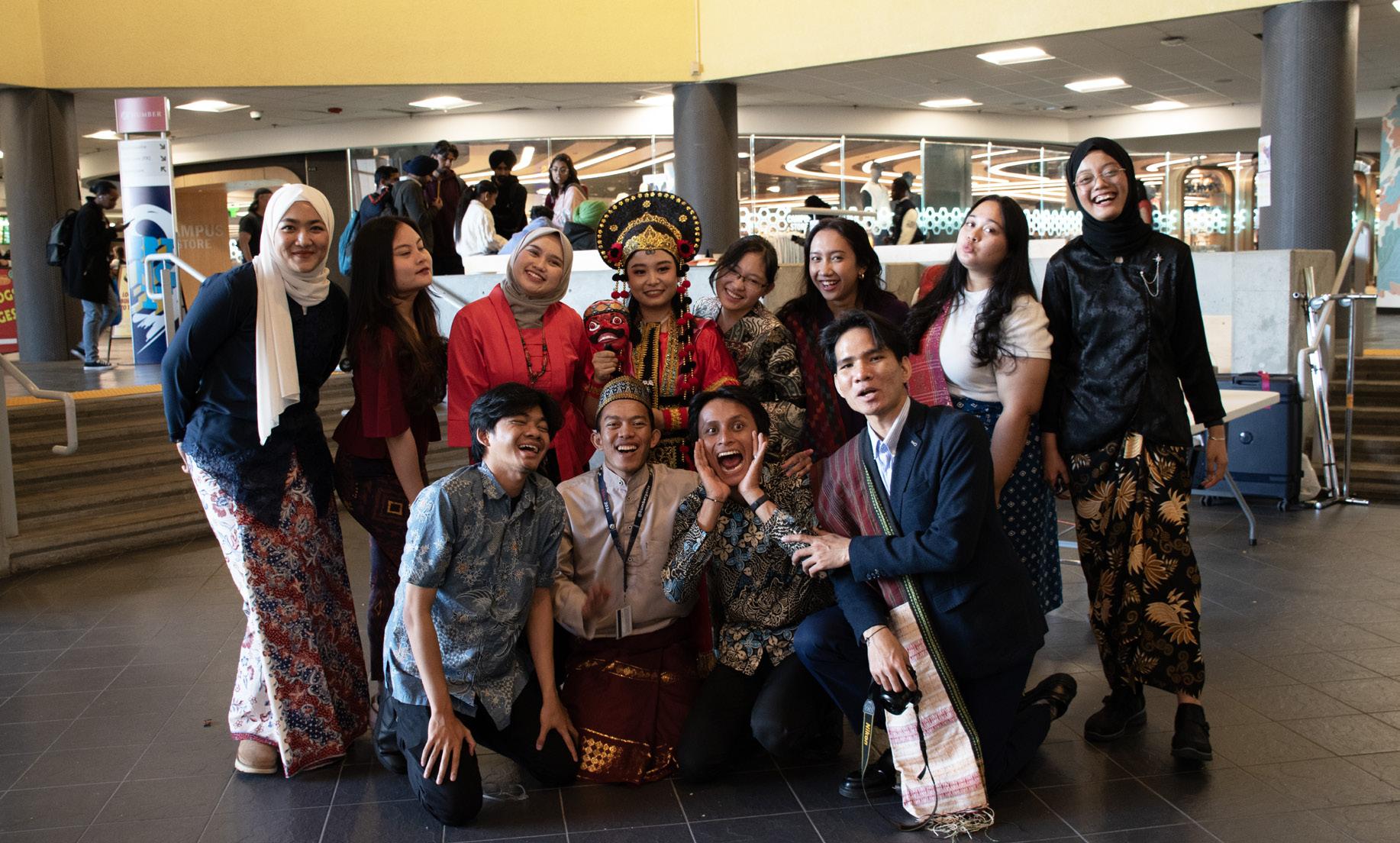HUMBER ET CETERA






Tait A. Graham HumberETC News
Ontario Premier Doug Ford gave Humber Electromechanical Engineer Technology students Paxton Coghlin and Dillon Kong the gold medals they earned at a recent competition.
Those medals emphasized the importance of skilled trades to the province’s economy as Ford officially opened the renovated and expanded Humber Polytechnic’s Centre for Skilled Trades on Thursday following three years of work.
The $9.5 million, 16,000-square-
foot expansion — including flexible lab spaces that can adapt to new industry technologies — to the Carrier Drive building in north Etobicoke is expected to help handle the growing demand for skilled trades.
Humber said a 10,000-squarefoot woodworking lab, converted from a former furniture manufacturing plant, will train students in trades such as carpentry and industrial woodworking.
“The expansion of Humber Polytechnics skilled trades programs is a major step forward for students pursuing opportunities

in the skilled trades,” Ford said.
“This expanded campus will help younger people in Toronto find better jobs with better pay cheques and help our province develop a highly skilled workforce that will attract investments and build roads, highways, schools, hospitals and other critical infrastructure that are essential to our growing communities,” he said.
Ford said the province will need to boost its electricity supply and that nuclear is the path forward.
“We need to double our energy in the next decade to keep up with the demand with these large facilities coming here,” he said.
The renovations were funded in part by Humber’s Capital Priorities Fund and with funding from the Ontario Apprenticeship Capital Grant.
The new renovations feature immersive labs including a Heating, Refrigeration and Air Conditioning lab, a gas and oil lab and an Augmented, Extended and Virtual Reality lab.
“The facilities are fully stocked and they have everything you need to learn and grow and to get the skills you need for the job,” said Vanessa Oweno, a new student in the Plumbing for Women program.
Nolan Quinn, the colleges and
Humber Et Cetera is the Humber Polytechnic journalism program laboratory newspaper. It is created by journalism students in the Advanced Diploma program. Et Cetera serves to inform the Humber community and give its readers well-rounded coverage on the things that matter to them.
universities minister, said the expansion of the “state-of-the-art facility” will help students learn hands-on skills needed to join the workforce.
“By providing the latest learning tools and equipment and creating 500 new skilled trades training opportunities, Humber Polytechnic is developing the talent we need to build Ontario and connecting students to meaningful careers,” he said.
Ann Marie Vaughan, the president and CEO of Humber, said the institution is committed to doing its part in improving the country’s “productivity crisis” by offering training in high-demand careers.
“Our mission is to equip graduates with the right skills and experience to build lifelong employability in a workforce that’s constantly evolving,” Vaughan said.
“With the expansion of the Centre for Skilled Trades and Technology, we are preparing the next generation of skilled workers to drive Ontario’s economy forward.
“Skilled trades professionals are the backbone of our economy, and we’re proud to offer facilities to ensure they receive the highest level of training,” she said.


Aislinn E. Millette HumberETC News
Pulitzer Prize-winning journalist and food industry expert Michael Moss says the business hooks consumers by adding unnecessary salt, sugar and fat to everyday items.
Moss told an audience at Humber Polytechnic’s North campus during the President’s Lecture Series talk on Wednesday that processed foods can be as, if not more addictive than tobacco.
Like tobacco companies tried to veer away from cancer, food processors tried to steer attention away from diabetes, he said.
Moss said he’s spoken with CEOs and scientists at large food companies to understand the marketing strategy and scientific research used to analyze how brains react to eating.
He said while conducting research, industry insiders told him that company leaders “don’t eat their own products, they know better.”
Moss said some corporate leaders were more afraid of being addicted to cookies than cigarettes.
At the Barrett Centre for Technology Innovation, Moss said the trillion-dollar processed food industry targets sensations rather

than nutrition. His lecture provided insight through his investigative journalism on how food companies hook consumers and stay loyal to their products.
Moss, the former New York Times reporter and the author of Hooked and Salt Sugar Fat, cited how Oscar Mayer felt people weren’t eating enough bologna. At the same time, they merged with Kraft, so they connected with marketing specialists and created Lunchables.
“What they were looking for here wasn’t like a food product, it was a product that was going to go into people’s deepest emotions,” Moss said.
Consumers don’t just eat for taste but also for texture, visuals, smell, and even crunch, he said.
Perfecting this combination is a theory called the bliss point, a concept created by Howard Moskowitz, who worked closely with Moss.
“(Moskowitz) came up with this idea that if you kind of perfect the formulas of food, you’ll get people to buy more and eat more, and the companies will make more money,” Moss told Humber Et Cetera before his talk. “He changed the amount of sugar in ordinary products and then subjected those to consumer taste tests.”
Moss discovered food companies weren’t only making junk

food items more addictive, but they were also tweaking shelf items like pasta sauce, canned soups and salad dressings to hook the consumer.
What this arguably did is make people expect sugar in everything they eat, so when trying to eat more vegetables, the brain is going to rebel and urge the person to return to processed food, Moss said.
A 2020 Statistics Canada found almost half of Canadians’ daily calories came from ultra-processed foods.
The Canadian Food Guide encourages people to stay away from ultra-processed foods that have high levels of added sodium, sugars and saturated fats.
Moss’s investigative research looks at how our brain becomes hooked to caloric-dense foods in a way that is as addictive in comparison to smoking cigarettes.
Rizwan Abdul Gaffoor, a prehealth student going into the bachelor of science and nursing course, was surprised to learn the marketing strategies behind food corporations.
“I really dislike companies when they do these sorts of things. I really do think companies should be more responsible with their products and their marketing,” he said.
Nathaniel Navarro, a second-year film student, is being considered for a nomination for a 2024 Short Film Competition Award in the Barrie Film Festival.
Navarro’s short film Reflections was nominated in the Simcoe County Category.
“It’s basically about my life and how I felt in my first semester in college,” he said. “This film is meant to be the basic personification of the looking glass self-theory, where you kind of put on all these different masks around certain people based off how they view you,” Navarro said. His love of content creation began at the age of seven.
“I made YouTube videos on my little camcorder as a kid,” he said. “I used to watch all these other YouTubers, and I was just like ‘Oh, I want to be one of these guys. I want to film.’”
Navarro said he wanted to pursue film to combine his love for storytelling and content creation.
He became an assistant film director in high school alongside his film teacher. Navarro’s biggest creative inspiration and support comes from his late grandmother.
He said he is bringing the rosary she gave him to the gala night, representing her constant presence with him, on Oct. 26 at the Galaxy Cinemas Barrie for the screenings and at The Canadian Brewhouse for the announcements of the awards.

Economic dependence sometimes creates a barrier for individuals trapped in abusive intimate relationships. When one partner controls the finances and housing, and the victim has limited employment opportunities because they are house-bound, it establishes a power imbalance that can entrap the other partner in the relationship. The partner who controls the money, and thus the power in the relationship, can manipulate the victim’s vulnerability because of a lack of resources or needed support systems to safely escape an abusive relationship.
Without any money or any independence, victims of domestic violence might not be able to afford the essentials, including food, shelter, health and transportation.
Financial abuse and control of women is a historical issue in Canada with women only being able to open bank accounts as of 1964.
Victims also worry about their children’s well-being.
They also feel the pressure to stay and take care of the children as they don’t have any money or a place to go.
Supportive resources such as access to shelters, job training and
legal services are essential for victims to escape, become more independent and move toward safety and stability.
A research study by the Canadian Centre for Women’s Empowerment stated Indigenous women are three times more likely to experience economic abuse than non-Indigenous women.
About six per cent of non-Indigenous women were forced to give money or possessions to their partners, and about 13 per cent of Indigenous women were denied access to employment, money or financial resources.
In the same study, about 86 per cent of victim-survivors were urged to quit work by their abuser, and 93 per cent of their abusers did not allow them to have any of their own money. They took their phones and their pay cheques.
In the study funded by Women and Gender Equality Canada, a survivor named Grace said she was forced to live with her controlling and abusive ex-husband for 10 years.
After she gave birth to her child, he started taking control of the family’s money. She worked long hours, and he would ask her to take out a credit and use her name to purchase the house.
Grace suffered violent trauma and
required many surgeries due to him constantly abusing her. A doctor told her she wasn’t allowed to work due to her anxiety and surgeries. In the end, she finally left him, but he took everything from her, except for a little bit of money left on her as she spent all of it on housing.
Grace did not have any access to legal support. She was denied social housing due to the value of her ex-husband’s property, and she was also denied a student loan because of a bad credit rating.
“I also was unable to receive social support from the government due to my ex-husband’s assets,” she told researchers. “I remember one day, I had no milk in my fridge and went to the food bank to feed my child.”
This research reported that 80 per cent of women agree that since COVID-19, their ex-partner has gotten more control or manipulative and changed their behaviour when it comes to finances and economics.
In early 2022, the Canadian Center for Women’s Empowerment surveyed victims to rate the helpfulness of various services. Doctors and mental health support services received a helpfulness rating of 41 per cent, followed by women’s shelters and organizations at 35.9 per cent and hospitals or clinics at 35.7
per cent.
Housing associations received a helpfulness rating of 33.6 per cent and welfare benefits 31.7 per cent. Homeless shelters received 31 per cent.
Statistics Canada’s 2004 General Social Survey found 653,000 women have reported they had been physically or sexually assaulted by their partner in the previous five years, and 17 per cent of women report experiencing emotional or financial abuse.
In the 2009 analysis of the Economic Impact of Spousal Violence, about 65 per cent of all homicides were connected to spousal violence, while more than 28 per cent of women experienced repeated abuse before reaching out to the police.
These statistics highlight both the serious impact and the delay in reporting this violence and the contribution to its substantial social and economic costs.
Females continued to report more serious forms of spousal violence than males despite equal victimization rates when all incidents were included. Addressing these challenges requires comprehensive social reforms that include support services and desperately needed financial aid to help individuals regain stability.

Sports are a major part of my life. Much of my time consists of living and dying with my favourite teams and watching amazing players make spectacular plays.
The atmosphere in arenas is truly special, but I’ve noticed a trend that I believe takes away from being in the moment.
While watching games on television, I constantly notice the fans in the crowd on their phones either recording the game or just on their phones being oblivious to the game.
According to a 2023 survey by Deloitte, out of the approximate
3,000 people surveyed, nearly 43 per cent of Gen Z participants (aged 12 to 27) use their phones at live sporting events to post on social media.
In some of the biggest historical sporting events, you can see that there is an abundance of fans on their phones trying to record the moment, instead of living in the moment.
On Feb. 7, 2023, Lebron James broke the NBA all-time scoring record, passing Hall of Famer Kareem Abdul-Jabbar’s record.
When James is about to shoot the ball which ultimately turned out to be the record-breaking basket, everyone except for a few people were on their phones recording the moment to post on social media.
On Sept. 19, 2024, Shohei Ohtani became the first-ever MLB player to achieve 50 homeruns and 50 stolen bases in a single season.
When Ohtani hit his recordbreaking 50th homerun, there were a lot of fans on their phones recording it, instead of living in the moment
and truly witnessing history.
If I were in a position where I were at one of the games mentioned above and the historical moment was about to happen, I would not pull out my phone and start recording. I feel like it would feel more real if I were in the moment experiencing greatness.
Michael Quinn, a third-year sociology student at Western University, said if he were in a position where history could happen, he would rather live in the moment rather than start recording.
“I wouldn’t pull my phone out and start recording,” Quinn said. “I’d much rather live in the moment and see the game through my own eyes.”
I don’t agree with fans that would pull out their phone and start recording. Social media has made it awarding for fans to post viral clips and get famous from it.
However, social media has been and continues to be beneficial for sports in ways that will bring fans closer to the game.
According to this study from the

University of Florida, social media plays a substantial role in bringing fans closer to the game.
The ability to stream games 24/7 allows fans to constantly participate in all sorts of aspects that brings the fans closer to their favourite teams and players, according to this study.
Quinn said being able to watch a five-minute highlight pack of a game is convenient for him if he is unavailable to watch an entirety of a game.
“Technology has made it easy for
me to catch up on any game that I miss,” he said. “If I’m doing homework or have other things to do, watching highlights on my phone is convenient for me.”
Social media has its perks when it comes to watching games and experiencing history in the making, but for me, nothing beats watching history unfold with just my eyes, no device needed.
Nicholas Rego, he/him, is a senior reporter and news editor at Humber Et Cetera and covers sports.
but we can’t


For just a toonie, a bag of ketchup potato chips drops from the vending machine with a satisfying thud. Its bright red packaging shines like a fire extinguisher, and the move to grab it is like an emergency.
This crunchy comfort snack has been my go-to during midterm season, painful periods and bouts of boredom since I landed in Canada two years ago.
The sweet yet tangy flavour met my tastebuds like a new friend, or so I thought.
It turns out junk foods are just as addictive as cigarettes, a 2023 study published in the British Medical Journal (BMJ) revealed.
These snacks are deliberately engineered to contain high amounts of sugar, salt and fat that hit a “bliss point,” a flavour peak that hijacks our brain and drives their products off the shelves.
The term “bliss point” was coined by Howard Moskowitz, an experi-
mental psychologist and market researcher. Big food corporations hire experts like Moskowitz to keep us eating more than we need to.
I eventually realized the industry meant to feed us is a foe, not a friend.
Indeed, the marketing tactics these companies use to create these learned cravings echo those employed by the tobacco industry.
The Truth Tobacco Industry Documents reveal how cigarette companies, which also owned food and beverage manufacturers, targeted children in the United States using cartoons, toys and advertising dollars to exploit nostalgia and cultivate loyalty to sugar laden products.
While these snacks may seem cheap, the real cost goes beyond our wallets.
A more recent study published in the BMJ found overconsumption of processed foods is linked to obesity, diabetes, heart disease, mental disorders and even cancer.
Eleven million deaths a year are tied to poor diet around the globe, according to a 2017 study published in The Lancet.
The researchers also found that a high intake of sodium and a low intake of whole grains and fruits were the leading dietary risk factors for death.
There’s irony in the fact that the onus of healthier eating is often placed on consumers when our
choices are predetermined.
A 2018 study funded by the Canadian Institutes of Health Research found that people believe unhealthy foods are far more than nutritious ones in university and workplace settings.
For example, Humber Polytechnic claims to prioritize healthy foods in its strategy report, but vending machines still display chocolate bars, candies, cookies and snacks.
One has to fork out $6.99 for a small pack of sliced melon that sits sadly in a campus fridge somewhere.
It is easy to see why almost twothirds of adults and one-third of children and youth in Canada are overweight or living with obesity, according to a March statement by the Public Health Agency.
For others, their food choices are even fewer.
High-sodium processed foods, such as pasta sauce and canned soups, dominate food banks and food rescue apps because of their long shelf life.
Natalie Riediger, an associate professor specializing in food equity at the University of Manitoba, told Humber Et Cetera in April that for someone budgeting, spending $4.99 on whatever is available can be a necessary choice, even if it means sacrificing nutrition.
A single, working parent or someone juggling two jobs may
also not have the time or energy for proper meal preparation.
Giant catering company Chartwells controls most of the food services across Humber’s campuses. Students have long complained about its mandatory meal plans, but yesterday’s protest attempt at Lakeshore didn’t gather any steam, revealing a lackadaisical attitude among students.
While any food is better than none, it’s important to realize that junk foods are a modern invention made with profit in mind.
Canada could follow the United Kingdom’s lead to control this ballooning epidemic.
The U.K. introduced the sugar tax on soft drinks in 2018, causing a drop in adult sugar intake by more than two teaspoons per day in the first year, according to a study by the London School of Hygiene and Tropical Medicine.
Furthermore, in early October of the following year, an advert ban for junk food, which applies to commercials shown on television before 9 p.m., will roll out to tackle childhood obesity.
Michael Moss, Pulitzer Prize-winning investigative journalist and author of Hooked, said in a President’s Lecture Series talk at Humber North campus that schools are accountable, too.
“It has to start with helping to educate [students] on the significance of food to their health and their ability to kind of make choices
for themselves,” Moss said.
To teach about food in an engaging rather than preachy manner, he said the addition of gardening programs and a new curriculum would motivate students to learn about the multinational companies and politics behind their food.
Moss said families should have open and honest conversations.
“When we would go to the cereal [aisle, me and my two boys] would play a game where we would ask them to look for a brand that had eight grams of sugar or less per serving.
“It would become an Easter egg for them,” he said.
I won’t claim quitting chips will be simple.
A gruesome picture of a person with a hole in his throat on a cigarette pack didn’t stop my dad from smoking. Pressure from us, his children, and chest pain did.
However, we don’t have to wait until it reaches the point of no return.
We can’t help ourselves.
But the combination of government regulations, community outreach, food education, fair income and better access to affordable whole foods would put the power back in the hands of consumers and guide us toward a world with genuine food as it once was.
Annicca Albano, she/her, is the editor-in-chief of Humber Et Cetera and covers food and social justice.
Benjamin Steeves HumberETC News
Having worked in the field for 10 years, Denis Lim always had a passion for helping young people who can’t help themselves.
As a Humber Polytechnic student who graduated in 2016 from the Addictions and Mental Health program, Lim now works for nonprofits and outreach and drop-in centres. He also teaches the same program he graduated from in Humber.
Lim acknowledges that while young adolescents continue to battle against mental challenges, society should shift its focus away from using the term mental illness.
“And when people say I have a mental illness and say I’m sick like there’s something wrong with me, there’s nothing wrong with you, we’re all human, we’re all anxious,” Lim said.
While World Mental Health Day was created in 1992 to raise awareness, mental health challenges have continued to persist.
A 2019 report by Trent University suggests more than 60 per cent of Canadian post-secondary students experienced higher than normal levels of stress within the previous 12 months, with 69 per cent saying they suffered severe
anxiety related to school.
The report discussed how 52 per cent of Canadian post-secondary students suffered from depression that prevented them from functioning normally, with other experts from The Higher Education Council of Ontario finding that COVID-19 exacerbated these issues.
“When you take a human being outside of their social networks, not online, but I mean, like their actual physical, social networks, somebody that checks in on them and asks them, how are you doing today, it is inevitable that they’re going to start spiralling downwards because they [feel like they] have nobody,” Lim said.
“I think it should be mandatory in class to have these kinds of discussions regardless of whatever program you’re in because, like, everybody’s got a mind, you know, everyone’s dealing with something,” he said.
Don Walin, an author who is a mental health advocate and a retired Professional Golfers Association (PGA) member who has lived with a bipolar condition for about 35 years, said mental health challenges can steal your life away in front of you without you even knowing.
“I call depression like a thief because it robs you of different

World Mental Health Day is a time to recognize those experiencing issues we can’t see, but it shouldn’t last one day.
things like motivation and inspiration and confidence, and it makes you procrastinate and all these other kinds of things,” Walin told Humber Et Cetera.
He said some of the mental challenges he dealt with within the workplace, where he would be fired during a “mental episode” and later refused to rehire, said because of the stigma around mental health, he felt as though he couldn’t mention it to his boss.
“I mean, it’s hard to be open and honest in the first place and
Parthvi Indravadan Patel HumberETC News
Humber Polytechnic’s Centre for Innovation in Health and Wellness (CIHW) launched a new research study with Klick Labs to detect prediabetes using voice recognition technology.
The research study aims to improve awareness and understanding about health screenings for young South Asians, who may be at risk of developing Type 2 diabetes in the future.
Currently, over 3 million Canadians, or 8.9 per cent of the population, are diagnosed with diabetes, a chronic disease that requires ongoing management and intervention.
The research targets the South Asian community, which faces a higher risk of Type 2 diabetes due to genetics, dietary habits, and lower BMI thresholds.
This project is incredibly important, especially for early intervention,” said Dr. Vanita Varma, CIHW Director. “South Asians have a predisposed genetic tendency to develop prediabetes and Type 2 diabetes. With many South Asian immigrants living in Canada, we are focusing on education and prevention in this high-risk group,” she said.
“Prediabetes often shows no symptoms, so many people may not even know they’re at risk. A simple voice recording could help identify risks, prompting testing, and follow up with their health care providers” Dr. Varma said.
Dr. Varma emphasized the need for targeted healthcare solutions for the South Asian population, as their diabetes risk often goes unnoticed until it progresses to a Type 2 diabetes stage.
“This innovative, easy-to-use
screening technology may change the landscape on early detection and prevention and thereby allowing for early intervention and timely healthcare access,” she said, underscoring the CIHW’s commitment to tackling health disparities in this community.
The study uses a machinelearning algorithm to analyze voice recordings for prediabetes risk factors. It detects subtle speech changes over just 10 seconds of voice data.
Participants simply speak into an app to help identify biomarkers in their voices that may indicate prediabetes risk. This method is non-invasive and totally accessible from any phone.
Dr. Varma said that this support shows how teamwork between different fields can help solve health problems.
to admit that you’re having some kind of problems and that you may have some kind of mental health issues or whatever,” Walin said. “But because of the stigma, it makes it that much harder for people, for sure.”
Not all workplace experiences have been negative when it comes to supporting mental health struggles.
Maria Talotta, a third-year Humber student in the Esthetician and Spa Management program, said work helped her manage her mental health.
“Work helps me with my mental health actually because it takes my mind away from the stress of school,” she said.
“Yes, work can be stressful, but it’s a different type of stress,” she said.
“I do feel work supports me with my mental health because if I’m ever going through a mental episode, my coworkers and managers are always open to hearing me out and giving words of advice,” Talotta said.
While mental stigmas continue to evolve, stigmas for men to express themselves are still prevalent, regardless of the position they find themselves in, Lim said.
“This idea that in order to be a man, this construct of a man, you’re supposed to always be strong, you’re never supposed to show any kind of emotion,” he said. “And if you even dare shed a tear at something, then you’re considered weak, and there are all these other vulgar terms and all vulgar names that people will call you.”
Men’s Mental Health Day was
on Oct. 10, but it’s important to remember these conversations don’t stop after one day, as mental health is an everyday issue.
Prime Minister Justin Trudeau said in a statement that raising awareness about the importance of mental health care involves “open and honest conversations about caring for ourselves and for others” while removing barriers preventing people from seeking help.
“Mental health matters,” he said. “It always has. But for too long, seeking support for mental health struggles was stigmatized. Like something to be ashamed about. And that made people struggle even more.”
In a report discussing men’s mental health done by Homewood Health, about one million Canadian men suffer from major depression each year.
The report found that, on average, around 4,000 Canadians take their own life each year, with three-quarters being men.
Mental health is a continuous challenge and something everyone needs to work on to maintain.
Walin said it’s important for that communication to feel welcomed and open.
“And that conversation, that communication is so important. because it helps break down barriers and stuff that makes people more comfortable to talk to you,” he said.
Lim discovered throughout his career that it’s okay for everyone to not feel ok. He wants people to be open about their struggles.
“Like, it’s okay to not be okay,” Lim said. “Life is not always just about being happy.”
Asher Klaver Opinion Editor
A student-led protest at Lakeshore campus against Humber Polytechnic and its food services provider Chartwells over mandatory meal plans on Thursday fizzled out with only four students showing up and the organizer developing cold feet.
The students showed up at the Lakeshore campus residence cafeteria, located on the sixth floor at 3199 Lakeshore Boulevard West, to protest high prices and mandatory meal plans which start at almost $3,000. Two uniformed security guards were also patrolling the
residence cafeteria anticipating a protest.
Chartwells had four meal plans this year and last, the cheapest option rose $500 to $2,850 over the summer. Chartwells technically did not raise the prices, but removed the option to choose the $2,350 “Bronze” plan and replaced it with a $4,600 “Diamond” plan. These plans, imposed by the polytechnic, are also non-refundable.
Kieran Baker, a supporter, was one of the few who showed up at the protest.
“I’m out here to protest the mandatory meal plans that Humber places upon the residence stu-

dents,” he said Thursday.
Baker wants this meal plan to be changed to be optional for students. He said he was disappointed in the turnout, but would start a petition to collect signatures from students.
“We’re all struggling to get by with bills adding up and this mandatory meal plan adds almost $3,000,” he said.
People showing up to sign the petition included students who had no idea the protest was occurring but were coming to the cafeteria to complain about the food quality and sanitation.
One student found hair in their breakfast.
Baker felt the petition was needed, especially with the disorganization.
“The organizer of the protest has failed to show up and it looks like there are only about three people here,” he said. “I just took it upon myself to write this petition because if I could get signatures on it for people who are not from the protest or had to leave early from the protest it would get their voices heard.”
Baker has also had his mental and
physical health affected by Chartwells putting stress and anxiety into his budgeting and giving small portion sizes that leave him famished.
“I have seen the dinner from the night before reorganized as a new dinner that they try to pass off at full price as well,” he said.
“It’s not frequent but it is an issue,” Baker said.
The protest organizer asked to remain anonymous out of fear of the threat of retaliation from Humber Polytechnic, it is also the reason he flaked on the protest itself.
He initially started organizing the protest as a joke after seeing posts on the social media platform Reddit about the poor food quality provided by Chartwells and the main demand to make the meal plan optional.
“There was a lot of anger and one day I saw a post asking why no one does anything about it?” He said in an interview earlier this month. “People in the comments said they can’t, I said we could. So I made a post just saying there’s a protest on Oct. 10.
“This year the food quality has gone down a lot,” he said. “People
have been served raw chicken, people have been paying insane amounts for just a dollop of creme cheese on a bagel, it’s stuff like that.”
The initial post had instant traction. In just a few days, over two dozen students personally told Hoss that they’d be attending, and he made an Instagram account for the protest.
This was an alien situation, especially for someone who never operated in protesting circles before.
“This is my first time. I am definitely not an activist,” the organizer said.
He said students seemed eager to support the protest.
“I didn’t take a lot,” he said. “The fact that somebody like me can start something means people are already on edge.
“I think it’s a huge scam,” he said.

Readmoreaboutthestudents’ protestforoptionalmealplansby scanningthisQRcode.

You have questions. You aren’t afraid to ask them. Now get the professional mentorship you need to help others make sense of the world through words. We show you how.
There is a story to be told here: mediaarts.humber.ca

Victoria Hincapie Gomez
Skedline.com
President of the Fashion Law Society, Emelia Thompson, 21, said one class in the Bachelor of Commerce and Fashion Management program inspired her to start the club.
“I really enjoyed learning about fashion law in my fashion industry analysis class with Professor Francesca D’Angelo. I wanted to create a club where this topic could be more explored and educate people,” she said. Thompson is in her final year and is thinking of enrolling in law school after graduation. She said there are legal aspects to everything in life, for better or for worse, and fashion law is not an exception.
“What I find the most interesting about fashion law is how
much goes into it, especially for beginner designers, and how important it is to legally protect their designs in this age of dupes and copyright infringement. There are many legal aspects when it comes to fashion, like trademarks, patents, intellectual property, sustainability legislation, employment, and trade agreements. This is where law and fashion meet,” she said. The Fashion Law Society has 20 embers. Meetings are held once a week in the Fashion Institute or other spaces on Lakeshore campus. In their socials, they tackle timely cases involving fashion law and fashion trends.
An example of a fashion law case reviewed by the society is Rolex v. La Californienne, a 2019 case in which the luxury watch manufacturer accused luxury watch
customizers La Californienne of trademark infringement, false description and representation. The ruling a year later permanently prohibited La Californienne from using or reproducing any Rolex trademark.
Last January, the society hosted an intellectual property law workshop in collaboration with the Humber Legal Association, where they explored intellectual property protections in fashion with guest speaker Alessia Monastero, a lawyer and trademark agent. Thompson said one of her favourite things about studying at Humber is how easy it can be to start a student club.
“This is one of the reasons I love studying at Humber. IGNITEe makes it easy to start your own club no matter what you’re interested in,” she said.
“Also, to other students thinking of creating their own clubs, I guarantee there would be people who share that same interest, it is just a matter of finding them.
“Thompson said all Humber students interested in fashion law can join the society.
“All students are open to join, not just students in fashion and law-oriented programs,anyone is welcomed,” she said.
Claire Bobert, 21, the society’s vice-president, is also in her final year in the Bachelor of Commerce and Fashion Management. Bobert said she had been friends with Thompson since their first year and wanted to do something extracurricular they both enjoyed. “We both wanted to do something fun together. I didn’t know
much about the law before, but Emelia is so passionate about it, and I love fashion, so I wanted to support her in creating this club,” she said. Bobert said her favourite part is having a sense of community.
“A lot of people in the fashion management program are in the club, so it gives us another thing to connect on,” she said. “It is also really interesting because we react to situations at the moment.
Fashion is so dynamic, and we see how things change with technology and how that affects legal aspects,” she said. Learn more about the Fashion Law Society, their upcoming events and relevant fashion law cases at: https://humberfashionlawso.wixsite.com.
Adrien Glazer
HumberETC Culture
Nuit Blanche took over Humber’s Lakeshore campus this past weekend, and many Humber students were allowed to showcase their work and explore this year’s theme, Bridging Distance.
This year’s artists were encouraged to explore ways that people interpret and experience the idea of distance. Jenny Fok is a graduate of the visual and digital arts program at Humber. Fok’s piece – titled Intertwined – consists of connected threads meant to have viewers reflect on the connections they may have between different times and places in their lives.
“We were thinking about distance, we explored a lot of definitions about distance instead of just physical and mentally, [and] we talked about time as well,” Fok said. “Finally we focused on the distance of time. We built our work trying to use something to connect you – the person himself or herself – to the past. So, it’s like every kind of memory and reflection. There are some relationships you just meet once in your lifetime and you might have forgotten it. So we try to link them up.”Fok collaborated on
this piece with two of her former classmates she connected with during her time at Humber: Chai Soriano and Indra O. Fok said the connections she made in her program were how they were able to
get work featured at Nuit Blanche.

“Indra and I have been friends since the very start of the program, and then I met [Chai] in a workshop hosted by Humber as well,” Fok said. “We met there as a student participant, and then after one year Chai was the one [who] had a great initiative to join [the workshop] and then she just briefly asked us if we wanted to join as a team.”In addition to the artists, many Humber students attended the event to show support to their peers.
Ikran Osman is a
Humber student and is also doing a work-study with Humber as part of the broadcast television program. She attended the event for work, but also to show support to her fellow students.“It’s really inspiring because I feel like as a student sometimes you’re always waiting to graduate or to be at a certain place to do these types of things,” says Osman.
“So, the fact that they get to have this opportunity to get recognition at such a huge event, I think it’s truly beautiful and inspiring.” A selection of exhibits will remain open to the public on Humber’s campus until Oct. 13. A full list of extended exhibits can be found here.

Culture Day at Humber Polytechnic was the perfect place to meet new people, try new dishes and learn more about Canada’s diversity.
The Wednesday event organized by First Year Experience hosted the annual event in the Theatre Concourse and attracted at least 100 people to the lecture theatre, where students celebrated and explored different cultures from around the world.
For some, it was a chance to showcase traditional activities and performances. Carrenina Oktavia Setyohandojo, an exchange student from Cirebon, Indonesia, in her first semester in the Hospitality Management program, performed an Indonesian folk dance called Tari Topeng Kelana, which uses five different masks, each representing a person’s life cycle.
She danced what is known as Fifth Mask on Wednesday, which represents bravery and the “firm personality of the person,” she said. “I really like how we explore and how we contribute to this event, as we contribute [to] our traditional culture also,” Setyohandojo said. “And we can see other cultures, not only from Indonesia, but also from India, Vietnam, Canada, and also
many more, and I’m really happy to see everyone in diversity.”
Walkidia Alcantara, from the Dominican Republic and in her first semester of the Pre-Health Program, enjoyed the event because of all the cultures at the school. “You gain knowledge about every culture,” she said. “It’s so nice to, like, have this opportunity to meet different traditions“I like this kind of challenge because it, like, let me know how much I know
about different cultures,” she said. Alcantara said the event had many things that represented each culture, such as the food, clothes, and dance. She said the Kahoot quiz, in which she placed second overall, was her favourite as she learned about other cultures.
“This event was amazing,” she said.
Juanita Rojas of Colombia is in her first semester of the PreHealth Science program, and she
looks forward to being a nurse. “I really like the event because you can, like, identify the differences between each country and culture,” she said. People learn about another country, and she finds it a beautiful and interesting thing. She said her favourite thing about the event was the Kahoot! game during the event because she won first place.
Rojas advises students to participate in all activities that Humber

provides “because you can learn, you can meet new people,” as it could be a way of making new friends, networking and getting contacts for the future.
Miral Qousi is from Palestine and is in her fourth year of the Kinesiology program at the University of Guelph-Humber. She was one of the volunteers representing the Middle East, and her club is part of the Middle Eastern Student Association, also known as MESA. It was the first time she’d heard of the event, so she decided to participate and represent her culture and her club.
“We had a table there, [it] went so great, we had Knafeh, which is a Middle-Eastern dessert, and we were doing, like, questions that people would win the desserts,” she said.
“I would love to let people know that they should come and visit. It’s very multicultural, you would get to know a lot of other clubs and where they originate from,” she said.
“Everybody was so supportive,” she said. Setyohandojo encourages others to come and visit Indonesia and Bali Island because of its culture.
“We really appreciate if you guys want to know more about us,” she said.
Samuel D. Brito Salas HumbetETC Sports
HAMILTON — The men’s Humber Hawks soccer team is the country’s top-ranked squad following the 4-0 rout of the Mohawks Mountaineers.
The team, currently ranked first in the country by the Canadian Collegiate Athletic Association (CCAA), was looking for an Oct. 5 win against the Mountaineers to stay on top of the Ontario Colleges Athletic Association (OCAA) West Conference over second-place Fanshawe Falcons.
Midfielder Jason Alvarado said after the game, the game initially didn’t go the way the team intended.
“It wasn’t going our way how we wanted it to,” Alvarado said. “(Second half) we got the clues that we needed.”
Although the final score reflects, in theory, an easy game for the Hawks, the game was hard-fought by both teams, especially during the first half.
Humber started with multiple goal chances, making Mountaineers goalkeeper Benjamin Temple the key in keeping the score tied at the start of the match.
Around the 12-minute mark, Mohawk was awarded a golden opportunity to take the lead with a penalty. But that vanished with a save by Humber’s goalkeeper Danial Sanei, keeping Humber’s clean sheet intact.
The rest of the first half continued with Humber dominating possession by keeping the ball in the last third of the pitch.
The second half started similarly to the first, with Humber continuing to press Mohawk until the first goal was scored around the 74th minute.
Midfielder Franz Mella took advantage of a free kick where Mohawk’s defenders were distracted, and it ended up with a red card to Mohawk’s player Nicholas Tavares, who tried to convince the referee of a bad call.
After that, Mohawk’s resistance collapsed, allowing Humber to score three more goals.
Head coach Michael Aquino said he was happy with the team’s performance, especially in the second half.
“I thought we created some chances, a little unlucky in the first half,” Aquino said. “We cleaned up things in the second half.”
He said he will rotate the team in the coming games to give rest to some players but also give more minutes to others.
Aquino said being the number one team in the country is not new for Humber.
“I don’t think it adds pressure,” he said. “I think it does add motivation.”
The men’s team are looking to keep up the pace for their last games, and Alvarado, who is in his final year at Humber, knows that very well.
“The plan’s to win the last two games,” he said. “To get to the playoffs number one in the West side.”
Humber played its last home game last Tuesday against the Redeemer Royals, which they won by 3-0, increasing their clean sheet streak to seven games.
Their final game of the season will be against the Fanshawe Falcons, currently in the second position of the OCAA.
The men’s team are looking to keep up the pace for their last games, and Alvarado, who is in his final year at Humber, knows that very well.
“The plan’s to win the last two games,” he said. “To get to the play-
offs number one in the West side.”
Humber played its last home game last Tuesday against the Redeemer Royals, which they won by 3-0, increasing their clean sheet streak to seven games.
Their final game of the season will be against the Fanshawe Falcons, currently in the second position of the OCAA.
He said he is very happy that
even with new players, the team is still at the top.
Left back Luca Pinto, who scored the second goal, said that the first goal was a relief for the team.
“I think that (the first goal) made us break through,” Pinto said. “We just started hammering them...”
He said to be at the top of the CCAA shows the quality and the team’s capability.


Rory Arthur
Using Artificial Intelligence in sports writing takes away the voices of real people and is just another way for big companies to cut costs.
ESPN is the main culprit of this, publicly admitting in a press release to begin using AI game recaps for all Premier Lacrosse League (PLL) and National Women’s Soccer League (NWSL) games in 2024.
The claim from ESPN is that using AI allows more coverage for underserved sports, giving leagues that did not previously have game recaps on their digital platforms more coverage.
“These sports do not currently have game recaps on ESPN digital
platforms, and these AI-generated recaps will be a tool to augment existing coverage – not replace it,” the release says.
Sports Illustrated was also caught using AI-generated stories, before deleting them all once they were caught.
So that leads to the burning question: why turn to AI rather than a human to cover these sports? Why can’t they hire writers to do the job they’ve turned to AI to cover?
In my opinion, it all comes down to cost-cutting. It’s yet another way to pay human writers less or paying fewer writers while still being able to pump out digital content.
It’s no secret the world of sports journalism is changing.
To circle back to our two AI examples, ESPN has gone through dozens of layoffs over the past year, while Sports Illustrated let go nearly their entire unionized staff in early 2024, leaving some wondering about the future of the once behemoth magazine before it was rescued by a licensing deal with Minute Media.
So, it’s clear these companies are
looking for ways to cut operating costs in a time of change.
But the point of this column isn’t to talk about the changing nature of sports journalism. It’s to highlight that AI-written pieces are not the solution.
Human writing simply cannot be replaced by that of an AI. Even when checked for accuracy by a human
editor, AI-written stories can only tell you what the data or prompt presented to them says.
AI doesn’t know the narrative heading into the game, it doesn’t see the incredible goal, the big save, or the slam dunk. It lacks the vision and the passion of sports writers, like the historical giants Saul “Red” Fisher of the Montreal Gazette, Trent Frayne

of the Toronto Star and Trent Frayne who wrote for the best of the country’s newspapers. They brought the passion for sports to life and the agony of losing championships into people’s living rooms.
AI just sees the data point laid out, or someone telling it that happened.
Take, for example, U.S. women’s soccer legend Alex Morgan’s final professional game for the NWSL’s San Diego Wave on Sept. 8.
The original AI-written match recap on ESPN had no mention of her. Only after it was publicly put out that this massive hole was gaping in the recap was it fixed to include a mention of Morgan.
If issues like this fall through the cracks, and require human editing, maybe it makes more sense to just have real people write these match recaps.
AI in sports writing is an industry trend that we can’t let pick up steam. It’s time to look towards the future of sports journalism. A future that highlights stories written by humans, not artificial intelligence.
No matter the cost.

After a 2-5-0 start to the
HumberETC Sports
HAMILTON — Last Saturday, on a sunny afternoon, the Humber women’s soccer team arrived in The Hammer to play against Mohawk on Tim Hortons Field, the storied home of the Tiger-Cats CFL team.
The Hawks, however, are not having their best season, so an away win on Oct. 5 would be a major help for what’s next. And they did with a 2-1 victory over the Mohawk Mountaineers.
Hawks’ goalkeeper Angela Volpe said how important the win was after the game.
“We deserved the win,” Volpe said. “We worked so hard, honestly, it’s a great feeling.”
Volpe was one of the best players in the game, making crucial saves to allow Humber to win.
The game started even, with chances for both sides however, the Mountaineers had the clearest chance with a double shot where Volpe made two very good saves.
A few minutes later, Hawks’ fourth year forward Chantell Spalla scored a header from a corner after Mohawk’s goalkeeper Samantha DeHaan missed the ball
in the air.
The Mountaineers took advantage of the Hawks’ missed chances and tied the game 15 minutes later after a defensive error coupled with a well-placed ball from the Mohawks’ third-year forward, Jaiden Morgan.
But Humber responded quickly, scoring the second and definitive goal of the match by forward Kaylese Callender.
The second half saw Mohawk trying to tie the game while Humber wanted to score the insurance goal, but neither team were able to capitalize on their chances.
Humber’s head coach, Jose Caro, was happy not just for the win but also for how the team reacted after Mohawk’s goal.
“The team responded really well after the 1-1,” Caro said. “Mentally, the team responded positively.”
He said in the past three games, the team has improved, so Caro is optimistic about the coming games.
Callender said the team played very well.
“I’m happy that our team is finally getting together,” she said. “It shows we’re progressing really well.”
She said frustration with some of the calls helped the team to focus and to take the three points home.
For the Hawks, this victory is the first of the season away from home.
And for Volpe, this result shows how the team has learned how to bounce back.
“Instead of focusing on the past, we’re focusing on the present and
future,” she said. “Just keep working harder to win and get further on in the playoffs.”
After last Saturday’s win, the Hawks are in sixth position after tying the Redeemer Royals 0-0 on Oct. 8, currently first in the West Conference.
The next and final game of the regular season will be this Saturday in London against the Fanshawe Falcons.
Mohawk’s head coach, Paul Giannini, said although his team gave everything, Humber played better.
“Whenever you can score first is huge,” he said.
“When you don’t score first, the momentum goes their way.”
He said the Mountaineers will look to end the season as best as possible and get ready for the playoffs.



